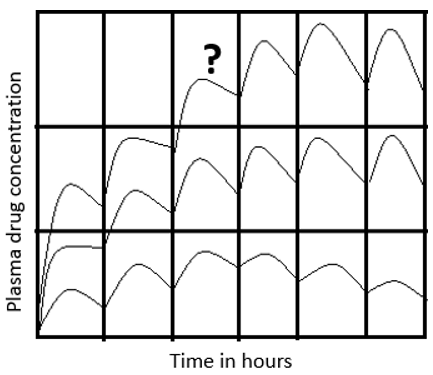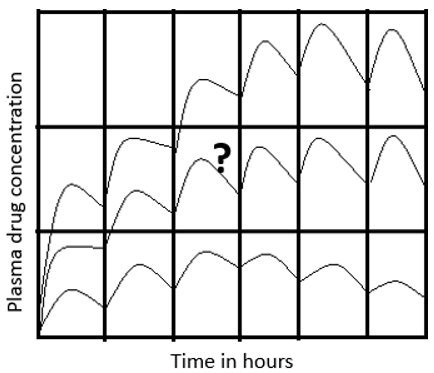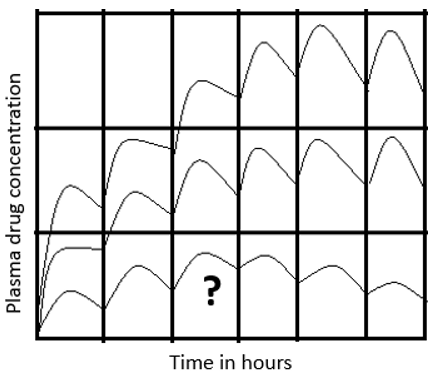This set of Drug Biotechnology Multiple Choice Questions & Answers (MCQs) focuses on “Pharmacokinetic Principles Applications – Dosage Regimens Design”.
1. What is dosage regimen?
a) The concentration of active agent in the drug formulation
b) The manner in which the drug is given to old people
c) The manner in which a drug is taken
d) The manner in which drug given to child
View Answer
Explanation: Drug regimen is defined as the manner in which a drug is taken. For some of the drugs such as hypnotics, antiemetics, analgesics, etc., a single dose is enough to provide its effective treatment on the patient. But for some of the diseases such as cholera, typhoid, the dosage of the drug has to be calculated and given for a longer amount of time. In these cases, drugs are to be taken on a repitative basis over a period of time.
2. What is the optimal multiple dosage regimen?
a) The concentration of active agent in the drug formulation
b) Dosage which maintains the plasma concentration within the therapeutic window.
c) The manner in which a drug is taken
d) The manner in which drug given to child
View Answer
Explanation: When the drug is administered in suitable doses with sufficient frequency to ensure that a stable plasma concentration is maintained which will be within the therapeutic window for the entire duration of therapy is known as optimal multiple dosage regimen. Drugs such as antibiotics a minimum effective concentration has to be maintained for all time till the patient heals.
3. In the given picture of a graph plotted between the plasma concentration versus time, the marked curve is for which kind of dosage?

a) Larger dose
b) Optimum dose
c) Smaller dose
d) Lethal dose
View Answer
Explanation: The marked curve is the curve showing larger dose profile. Greater the dose, greater the fluctuations during each dosing interval and greater the chances of toxicity. The graph shows both therapeutic and toxic responses. The curve in the middle is for optimum dose profile. The curve below that is for smaller dose profile.
4. In the given picture of a graph plotted between the plasma concentrations versus time, the marked curve is for which kind of dosage?

a) Larger dose
b) Optimum dose
c) Smaller dose
d) Lethal dose
View Answer
Explanation: The marked curve is showing the profile for optimum dose profile. The optimum dose is therapeutically successful. It does not show larger fluctuations neither it reaches the toxic concentration. The curve in the upper side is for larger dose profile. The curve below that is for smaller dose profile.
5. In the given picture of a graph plotted between the plasma concentration versus time, the marked curve is for which kind of dosage?

a) Larger dose
b) Optimum dose
c) Smaller dose
d) Lethal dose
View Answer
Explanation: The marked curve is the curve for smaller dose profile. It shown minimal fluctuations. But the smaller dose is therapeutically ineffective. It does not reach the minimum effective concentration. The curve in the upper side is for larger dose profile. The curve below that is for optimum dose profile.
6. On what basis the dose interval is calculated?
a) Active drug concentration in the formulation
b) Half-life of the drug
c) Duration of the disease
d) Age of the patient
View Answer
Explanation: Any dose frequency is being calculated on the basis of half-life of the drug. If the interval is increased without changing the dose, Cmax, Cmin, Cav decreases but the ratio of Cmax/Cmin increases. Opposite can be observed if dosing interval is reduced frequency increased. It can also result in accumulation and toxicity.
7. What is fluctuation?
a) Cmax/Cmin
b) Cmin / Cmax
c) 1/Cmin
d) 1/Cmax
View Answer
Explanation: Fluctuation is defined as the ratio between Cmax and Cmin. Greater the ratio greater fluctuations will be seen in the graph. Fluctuations depend upon the dosing frequency and half-life of the drug. It also depends upon the rate of absorption. Greatest fluctuation can be seen when the drug is administered as a i.v. bolus.
8. How do you calculate the ideal body weight for men?
a) 50 kg +- 1kg/2.5cm above or below 150 cm in height
b) 45 kg +- 1kg/2.5cm above or below 150 cm in height
c) 40 kg +- 1kg/2.5cm above or below 150 cm in height
d) 35 kg +- 1kg/2.5cm above or below 150 cm in height
View Answer
Explanation: The volume of distribution of drug gets affected by the changes in body weight. Since increase in the body weight is directly related to the volume of various fluids. The ideal body weight of a man can be calculated by 50 kg +- 1kg/2.5cm above or below 150 cm in height and for woman 45 kg +- 1kg/2.5cm above or below 150 cm in height. Any person whose body weight is more than 25% and above the IBW is considered to be obese.
9. How do you calculate the ideal body weight for a woman?
a) 50 kg +- 1kg/2.5cm above or below 150 cm in height
b) 45 kg +- 1kg/2.5cm above or below 150 cm in height
c) 40 kg +- 1kg/2.5cm above or below 150 cm in height
d) 35 kg +- 1kg/2.5cm above or below 150 cm in height
View Answer
Explanation: The volume of distribution of drug gets affected by the changes in body weight. Increase in the body weight is directly related to the volume of various fluids. The ideal body weight for woman 45 kg +- 1kg/2.5cm above or below 150 cm in height. Any person whose body weight is more than 25% and above the IBW is considered to be obese.
10. Which of the following drugs are lipid soluble?
a) Phenytoin
b) Caffeine
c) Digoxin
d) Antibiotics
View Answer
Explanation: Drugs such as phenytoin, diazepam, and thiopental are lipid soluble, these drugs get distributed to the adipose tissue more, and thus increases the volume of distribution. In obese patients’ volume of distribution is larger per kg body weight and thus requires larger doses more than total body weight basis.
11. Which of the following drugs get distributed to the same extent in both lean and adipose tissue?
a) Phenytoin
b) Caffeine
c) Digoxin
d) Antibiotics
View Answer
Explanation: Drugs such as caffeine, theophylline, lidocaine and lorazepam gets distributed in same extent in both lean and adipose tissues, the volume of distribution is larger in the obese patient but same when we calculate for per kg total body weight basis, hence dose should be administered n total weight basis. For polar drugs for e.g. antibiotics which distribute in excess body space of obese patients to an extent less than that in lean tissues.
12. Which of the following drugs can get distributed to the excess body space of obese patient?
a) Phenytoin
b) Caffeine
c) Digoxin
d) Antibiotics
View Answer
Explanation: For polar drugs for e.g. antibiotics which distribute in excess body space of obese patients to an extent less than that in lean tissues. Thus, the dose should be lesser on per kg total body weight basis but more than that on IBW basis. Drugs such as caffeine, theophylline, lidocaine and lorazepam get distributed in same extent in both lean and adipose tissues. For drugs such as digoxin which do not distribute in the excess body space, the volume of distribution does not change and hence dose for administration to a patient should be calculated on the basis of ideal body weight.
13. Which of the following drug can get distributed in the excess body space?
a) Phenytoin
b) Caffeine
c) Digoxin
d) Antibiotics
View Answer
Explanation: For drugs such as digoxin which do not distribute in the excess body space, the volume of distribution do not change and hence dose for administration to a patient should calculated on the basis of ideal body weight. For polar drugs for e.g. antibiotics which distribute in excess body space of obese patients to an extent less than that in lean tissues. Drugs such as caffeine, theophylline, lidocaine and lorazepam gets distributed in same extent in both lean and adipose tissues.
14. Neonates, infants and children require different dosages than adults.
a) True
b) False
View Answer
Explanation: Neonates, infants and children require different dosages than adults because differences in body surface area, TBW, and extracellular fluid volume per kg body weight basis. The dose for such patients are calculated on the basis of the surface area of the babies not the body weight basis because surface area correlates better with dosage requirement, cardiac output, renal blood flow and glomerular filtration in children.
15. Accumulation occurs because drug from previous doses was not being removed completely.
a) True
b) False
View Answer
Explanation: The given statement is completely true. Accumulation of any drug occurs because the previous amount of drug was not being completely removed from the body. As the amount of drug in the body rises due to accumulation, the rate of elimination also rises proportionally until a steady-state or plateau is reached when the rate of drug entry into the body equals the rate of exit.
Sanfoundry Global Education & Learning Series – Drug and Pharmaceutical Biotechnology.
To practice all areas of Drug and Pharmaceutical Biotechnology, here is complete set of 1000+ Multiple Choice Questions and Answers.
If you find a mistake in question / option / answer, kindly take a screenshot and email to [email protected]
- Practice Biotechnology MCQs
- Apply for Biotechnology Internship
- Check Drug and Pharmaceutical Biotechnology Books
- Check Biotechnology Books
